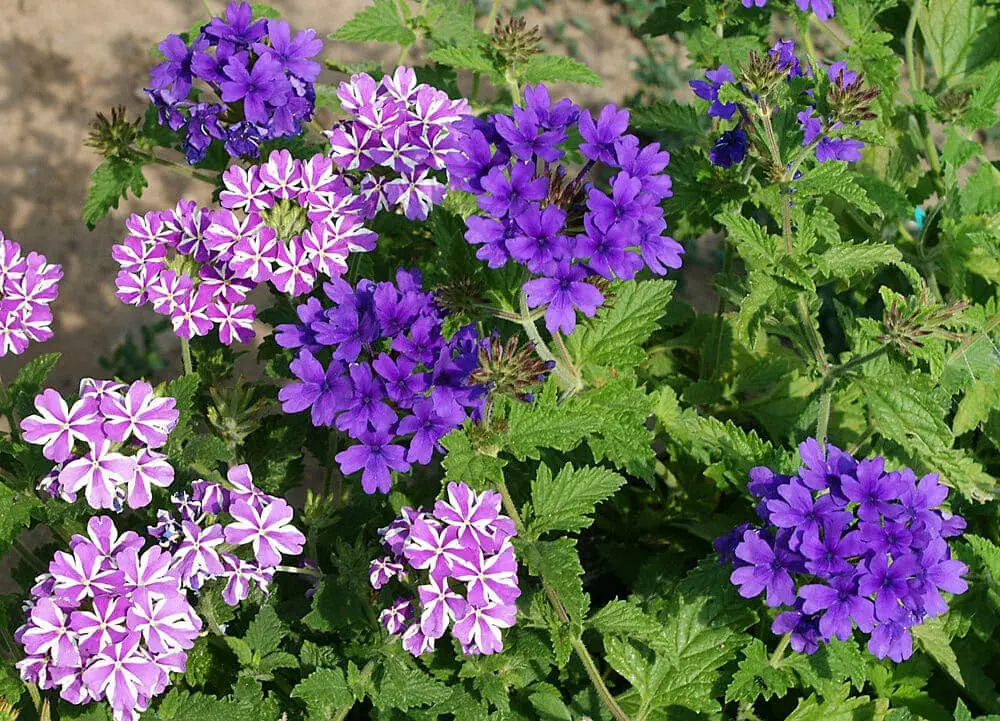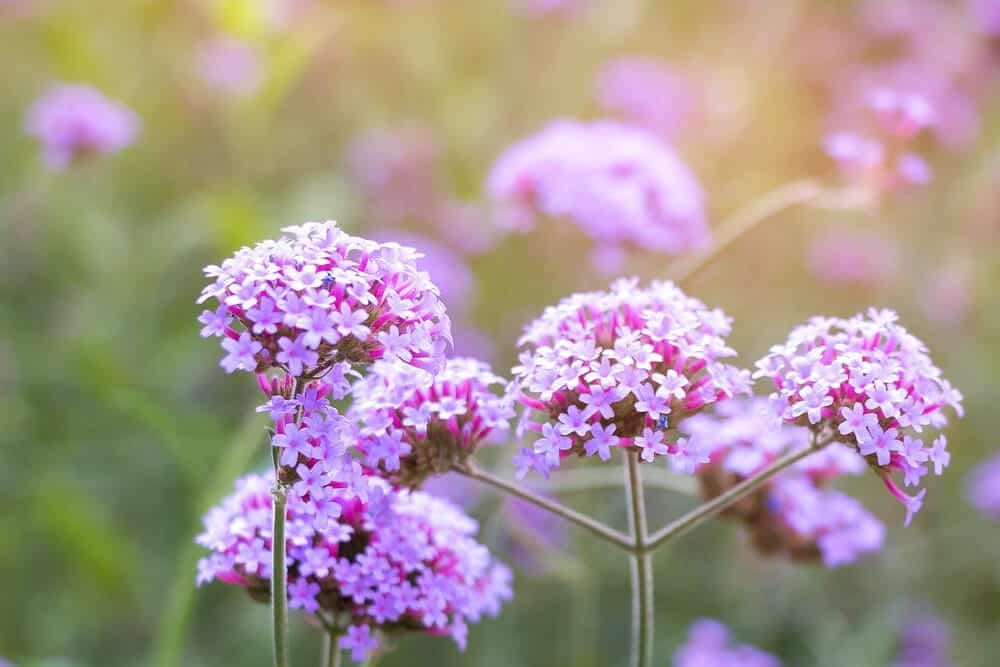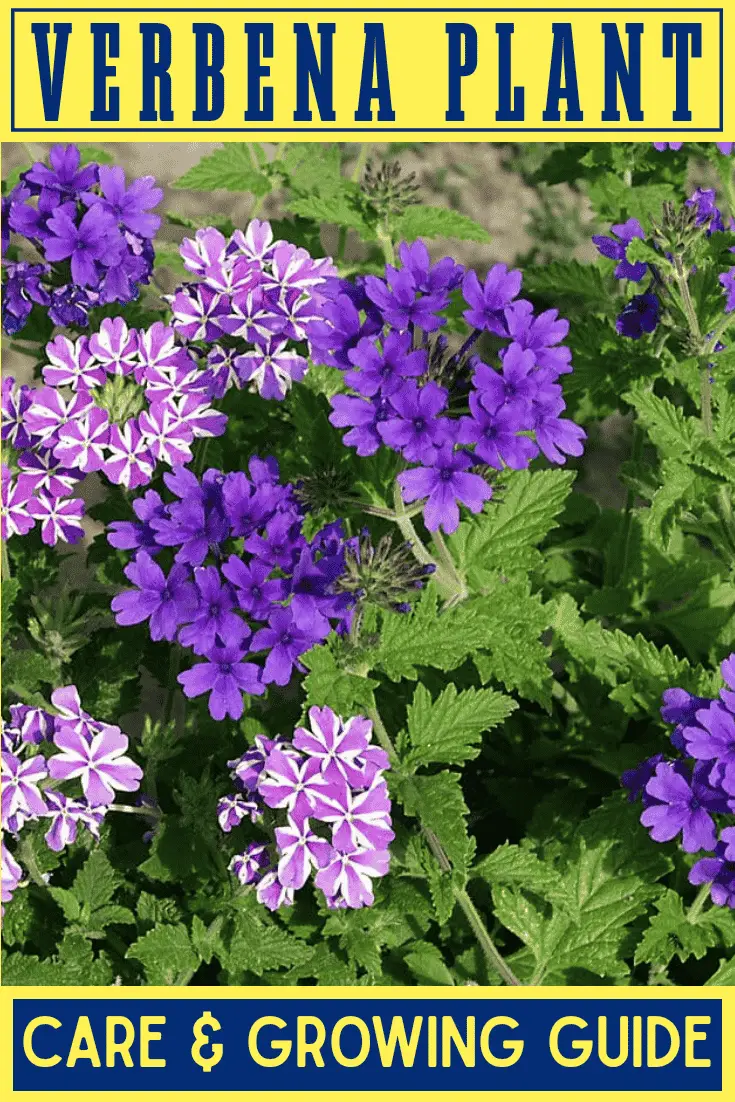The long stems and two-colored flowers are a sight you’ll never forget when you see the Verbena Plant in person.
It sways softly in the wind, and its bloom livens up any area. This plant is often used in aromatherapy, and as an essential oil.
Verbena Plant Care & Growing Guide
1. Light Requirement
The verbena plant loves to be in the sun. It requires at least eight hours of full sun every day, so keep it in a sunny spot. It can live in indirect light or partial shade, but the leaves won’t be as strong, and the flowers will be lackluster and dull. It doesn’t do well under artificial lighting. If it’s an indoor plant, keep it the brightest room you have, preferable where the sun’s rays can hit it.
2. Water
Overwatering this plant is a death sentence, so be careful. In fact, water-based diseases are the most significant problems you’ll try to avoid when you own this plant. When there is no heat, an inch of water is enough for the week. But when the heat and sun grow more robust, you’ll have to test the soil every day to see if it’s drying out. It is a drought-resistant plant, so you don’t have to water it so much. But the less water it receives, the less its flowers will bloom. If it is hot, rewater it and turn the soil moist. Do not water the plants from above; only water them under their foliage.
3. Climate and temperature
Verbena plants love the heat. It is a desert plant and has no problem standing tall during the hottest days of the year. These plants do best in hardiness zones 7, 8, and 9. If a verbena is growing from propagation, it is better designed to handle the heat.
4. Soil
This plant can grow in most types of soil, even if the nutrition is poor. But the ground needs to drain well, or it can die if it is overwatered too often or if there is a long rainy season. For better plant structure and bloom, it is recommended that you add fertilizer pellets to the soil.

5. Speed of Growth
Depending on the type of verbena it is, they will have a moderate to fast growth rate. Some of the verbenas grow so fast they extend past their containers and barriers in no time. This is why gardeners must trim the plant so often.
6. Height and Width of the plant
The height and width of the verbena plants vary wildly, but on average, they can grow from one to three feet tall and have a width of six to 12 inches. Some varieties can grow taller than five feet. Their size depends mostly on the amount of sun they receive and how well they are trimmed.
7. Trimming
Proper trimming is essential to this plant because if it doesn’t have to waste nutrients and energy on large leaves and dead matter, then it can dedicate that energy to its flowers. After the first bloom, slowly trim back the entire plant to make way to a second bloom. This plant requires regular maintenance.
8. How to propagate a verbena plant?
Propagating a verbena plant is quite easy. Choose a long stem and cut off a piece that is around 4 inches, ending the cutting directly below a node so that the node can become an extra leaf. Many people dip the cutting in root hormone to encourage rooting, but you don’t have to. Place the cuttings in water and leave it next to a window that receives a lot of sun. In a few days, you should start to see roots. Once the roots appear, bury the cutting an inch or so into a pot with soil. Keep the soil moist and under direct sunlight.
Is the Verbena Plant Poisonous?
Most of the varieties of verbena plants are non-toxic and won’t poison humans or animals if they eat the berries or flowers. The only species of verbena that is toxic to animals is the purple top verbena.

Can Verbena Plant Plants grow in water?
Although verbena plants like to be watered well, none of them can grow in water. They do not do well in swamps and bogs, and excess water around their roots can kill them.
Does this plant have flowers and how to get it to flower?
Yes, the Verbena plant has flowers. These plants come in a multitude of colors and grow in circular batches. They usually bloom from summer to fall. The flowers of verbena plants are robust and have no problem blooming during the hottest days of the year.
More like this: Golden Dewdrop Care & Growing Guide
Common Verbena Plant Diseases
Powdery mildew is when a white fungus grows over the leaves and stems of a plant. This mildew is common to see. If it doesn’t become bigger, then it is only an aesthetic problem. But if it does keep growing over the whole plant, it could stunt a plant’s growth and cause leaves to dry up. To remove it, first cut off all pieces of the plant that are infected. Throw them away. Second, apply neem oil spray or a mixture of baking soda and water to the entire plant.
Gray Mold is a sneaky killer, and if you don’t catch it in time, this fungus can kill your plants. The verbena plant can contract gray mold is there is too much moisture around, and a gray mold spore lands in warm wet soil. First, it infects the leaves, and then gradually moves to stems, flowers, and roots. Gray streaks will appear first over the leaves. It then turns the surface of the plant black and causes it to die. To remove the gray mold, you first have to remove all infected parts and throw them away. Then, spray the whole of your remaining plant with a potent fungicide.
Also read:
Conclusion
- This plant’s nickname is The Tear of Isis.
- In mythology, this plant stopped the blood flowing from the hands of Jesus when he was taken down from the cross.
- Watering this plant is tricky! Too much and it can get root rot. Too little and the flowers and leaves could wither up.
- Because of their bright and beautiful flowers, butterflies love to flock around verbena plants.
- These plants are nontoxic to humans
- Trim the verbena often because they grow quite fast.
- This plant loves direct sunlight and needs about 8 hours of it a day.

Victoria is the owner and main author of hobby plants. She loves spending her free time in her garden planting and taking care of her plants. Victoria hopes you enjoy the content here!
![Mother Of Thousands Plant [Complete Plant Care Guide] Mother Of Thousands Plant [Complete Plant Care Guide]](https://www.hobbyplants.com/wp-content/uploads/2022/07/mother-of-thousands-plant-300x158.jpg)
![Majesty Palm Plant Care: [Complete Beginner's Guide] Majesty Palm Plant Care: [Complete Beginner's Guide]](https://www.hobbyplants.com/wp-content/uploads/2022/08/majesty-palm-care-300x158.jpg)
![Exotic Angel Plant Care: [Complete Beginner's Guide] Exotic Angel Plant Care: [Complete Beginner's Guide]](https://www.hobbyplants.com/wp-content/uploads/2022/08/exotic-angel-plant-care-300x158.jpg)
![Snow White Waffle Plant: [Complete Care Guide] Snow White Waffle Plant: [Complete Care Guide]](https://www.hobbyplants.com/wp-content/uploads/2022/08/snow-white-waffle-plant-300x158.jpg)
![Waffle Plant Care: [Complete Beginner's Guide] Waffle Plant Care: [Complete Beginner's Guide]](https://www.hobbyplants.com/wp-content/uploads/2022/08/waffle-plant-300x158.jpg)
![Bird Of Paradise Plant Care: [Complete Beginner's Guide] Bird Of Paradise Plant Care: [Complete Beginner's Guide]](https://www.hobbyplants.com/wp-content/uploads/2022/08/bird-of-paradise-plant-300x158.jpg)
![Purple Passion Plant Care: [Complete Beginner's Guide] Purple Passion Plant Care: [Complete Beginner's Guide]](https://www.hobbyplants.com/wp-content/uploads/2022/08/purple-passion-plant-care-300x158.jpg)
![China Doll Plant Care: [Complete Beginner's Guide] China Doll Plant Care: [Complete Beginner's Guide]](https://www.hobbyplants.com/wp-content/uploads/2022/09/china-doll-plant-care-300x158.jpg)
![Polka Dot Plant Care: [Complete Beginner's Guide] Polka Dot Plant Care: [Complete Beginner's Guide]](https://www.hobbyplants.com/wp-content/uploads/2022/09/polka-dot-plant-300x158.jpg)
![Mona Lisa Lipstick Plant Care: [Complete Beginner's Guide] Mona Lisa Lipstick Plant Care: [Complete Beginner's Guide]](https://www.hobbyplants.com/wp-content/uploads/2022/09/lipstick-plant-mona-lisa-300x158.jpg)
![Yucca Cane Plant Care: [Complete Beginner's Guide] Yucca Cane Plant Care: [Complete Beginner's Guide]](https://www.hobbyplants.com/wp-content/uploads/2022/09/yucca-cane-plant-care-300x158.jpg)
![Bush On Fire Croton Plant Care: [Complete Beginner's Guide] Bush On Fire Croton Plant Care: [Complete Beginner's Guide]](https://www.hobbyplants.com/wp-content/uploads/2022/09/bush-on-fire-croton-300x158.jpg)